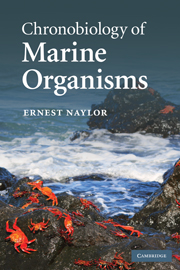Book contents
- Frontmatter
- Contents
- Preface
- 1 Moonshine
- 2 Biorhythms of coastal organisms
- 3 Tidal and daily time-cues
- 4 Clocks and compasses
- 5 Lunar and semilunar biorhythms
- 6 Annual biorhythms
- 7 Plankton vertical migration rhythms
- 8 Staying put in estuaries
- 9 Ocean drifters
- 10 Living clockwork
- References
- Author index
- Subject index
- Plate section
10 - Living clockwork
Published online by Cambridge University Press: 05 June 2012
- Frontmatter
- Contents
- Preface
- 1 Moonshine
- 2 Biorhythms of coastal organisms
- 3 Tidal and daily time-cues
- 4 Clocks and compasses
- 5 Lunar and semilunar biorhythms
- 6 Annual biorhythms
- 7 Plankton vertical migration rhythms
- 8 Staying put in estuaries
- 9 Ocean drifters
- 10 Living clockwork
- References
- Author index
- Subject index
- Plate section
Summary
The possession of a time sense allows an organism to set in motion at the proper time, processes whose final stage should be synchronized with set phases of a rhythmical environment
Janet Harker, 1964Ever since publication of the challenging scientific article entitled Biological clock in the unicorn (Cole, 1957), research concerning the rhythmic behaviour and physiology of plants and animals has overwhelmingly supported the view that such processes are not controlled solely by cyclical changes in the environment, however subtle some of those variables might be. It has long been apparent that biorhythms can be expressed spontaneously, at periodicities somewhat different from those of geophysical variables, in isolation from the environment, leading to the conclusion that some form of internal biological clockwork is involved in their timing. It has been questioned as to how this free-running ability has provided adaptive advantage during the evolutionary process (Winfree, 1987) but, as discussed in Chapter 3, it seems to follow logically if, as appears to be the case, endogenous rhythmicity provides an organism with anticipatory capability in relation to potentially adverse or favourable phases of their cyclical environment. For example, for photosynthetic unicellular organisms early in evolution, anticipatory circadian physiology would permit the capture of the first photons at dawn (Suzuki and Johnson, 2001), would permit favourable phasing of incompatible processes such as photosynthesis and nitrogen fixation (Mitsui et al., 1986) and permit favourable phasing of cellular events that are inhibited by sunlight (Pittendrigh, 1993).
- Type
- Chapter
- Information
- Chronobiology of Marine Organisms , pp. 181 - 210Publisher: Cambridge University PressPrint publication year: 2010



